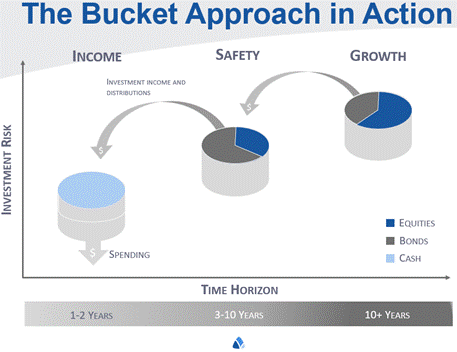The Bucket Approach to Retirement Allocation
Aug 9, 2022 • Written by Paul Staib | Certified Financial Planner (CFP®), MBA, RICP®
Blog Home » Retirement Income » The Bucket Approach to Retirement Allocation

Achieving your retirement income needs with a diversified portfolio created using a time-based framework
Retirees often struggle with determining an effective and appropriate strategy for managing their investment portfolio to meet their retirement income needs. Of primary concern is whether the amount of money saved will be sufficient to fully fund your retirement. There are also distribution factors to consider, including how to withdraw funds from different retirement accounts and investments. Add rising inflation and interest rates, and increased market volatility to the equation (not to mention the emotions associated with it all!) and it’s easy to become overwhelmed.
The bucket approach to retirement-portfolio management aims to meet those challenges, effectively providing a framework to help retirees create a secure paycheck from their investment assets, while minimizing the risk of pulling from the portfolio during market downturns.

What Is the Retirement Bucket Strategy?
The retirement bucket strategy is an investment approach that segments your sources of income into three time-based buckets. Each bucket has a defined purpose based on when the money is needed: immediate (short-term), intermediate, and long-term.
This bucketing concept for managing retirement income and investment portfolio strategy is anchored on the basic premise that assets needed to fund near-term living expenses ought to remain in cash, and not be exposed to fluctuations of the market. This cash buffer provides the peace of mind to ride out periodic downturns and volatility in the long-term portfolio. Assets that won’t be needed for several years can be allocated in a diversified mix of long-term holdings. The buckets are periodically and opportunistically refilled over time – via interest income, dividends, and the performance of your investments.
The Retirement Buckets
The bucket strategy entails dividing your savings into three buckets, each invested in a different way to achieve distinct objectives and for different planned timeframes. Here’s a summary of each retirement bucket:

The Income Bucket contains the next 1-2 years’ worth of planned spending – it is essentially the source of your “retirement paycheck” for the period. Liquidity and safety of principal are critical, and as such, the money is allocated to cash/cash equivalents that are not subject to loss of principal due to market fluctuations.
The Safety Bucket contains years 3-10 worth of planned spending. The purpose of this bucket is to provide steady, reliable income, and an inflation hedge. It is conservatively invested to protect assets from the dangers of market risk, interest rate risk, and sequence of returns risk.
The Growth Bucket contains planned spending for 10+ years away. The objective of this allocation is growth and appreciation to outpace inflation over time.
Having allocations to the first two buckets buys retirees a ~10 year time horizon, so you can confidently invest the balance of your assets for long-term growth in the third bucket.
The bucket strategy is an approach to structuring your assets to provide reliable income when you need it (via the Income and Safety Buckets), andto grow your money over long-term time horizons (via the Growth Bucket) to battle inflation throughout retirement.
In this way, the retirement bucket strategy provides a bit of a safeguard against market ups and downs. When the stock market is down, you can rely on cash sourced from the Income (and Safety) bucket. When the market goes up, you might draw from the second and third buckets. Some of these funds could be used to replenish the cash bucket. You are then ready for another downturn, at which time you can access money from the cash bucket.
Why the Bucket Approach is so Useful
The bucket plan planning process has many benefits in addition to being an effective way to position assets for a secure retirement.
- Easy to Understand: the bucket approach is relatively simple and straightforward, easy to understand, and makes intuitive sense; making it an excellent strategy for retirees to get comfortable with and commit to;
- Mitigate Risks: very effective strategy for minimizing several risk factors associated with retirement planning, including Sequence of Return Risk, Market Risk, and Inflation Risk;
- Helps Avoid Mistakes: within the bucket plan each bucket has a purpose and helps you avoid making bad decisions that could hurt your long-term plan. Knowing that money for you near-term spending needs is secure in cash helps you cope with the fluctuations that will inevitably accompany the stock/bond portfolio. This structure prevents a lot of the panic and poor decision making that often occurs during times of market volatility;
- Diversified / Time-Segmented portfolio: the bucket approach aligns your time horizon with an investment approach, which may help you be more comfortable with maintaining a well-diversified, long-term portfolio allocation, with a focus on total return (not just income generation)
- Customizable / Flexible: the bucket approach is flexible and easily customizable; the allocations – and investments – to each bucket can be easily tailored to your personal comfort level for both volatility and risk; ultimately providing you with the security, stability, and confidence to enjoy your retirement
- Built on Investment Principles: three principles of sound investing include consideration of time horizon, diversification, and risk tolerance. A well-designed Bucket Strategy is built using all three principles in its foundation
Flexibility in Implementation
The bucket approach represents a starting framework for structuring your assets to provide reliable income throughout retirement. How you actually divide your money amongst the buckets – and to which specific investments – can be very flexible and will often depend upon:
- How much you have;
- How much income you need to live on and when you need it;
- How many years you plan to need the income for;
- What rate of return and rate of inflation you predict;
- Your level of risk capacity (how much risk you’re financially able to accept) and risk tolerance (how much risk you’re willing to accept)
Summary
The bucket approach is a simple framework to structuring your assets to provide reliable income when you need it and to grow your money to outpace inflation throughout retirement. Your customized bucket plan will make it possible for you to enjoy your retirement while worrying less about the volatility of the stock market and interest rates, or the potentially devastating hazard of sequence of returns risk. By segmenting your money into three different buckets based on your investment time horizon, volatility tolerance, and income need, you can eliminate certain risks and avoid making bad decisions that could cause you to run out of money in retirement.

Paul Staib | Certified Financial Planner (CFP®), MBA, RICP®
Paul Staib, Certified Financial Planner (CFP®), RICP®, is an independent Flat Fee-Only financial planner. Staib Financial Planning, LLC provides comprehensive financial planning, retirement planning, and investment management services to help clients in all financial situations achieve their personal financial goals. Staib Financial Planning, LLC serves clients as a fiduciary and never earns a commission of any kind. Our offices are located in the south Denver metro area, enabling us to conveniently serve clients in Highlands Ranch, Littleton, Lone Tree, Aurora, Parker, Denver Tech Center, Centennial, Castle Pines and surrounding communities. We also offer our services virtually.
Read Next
What’s In Your Credit Score
• Written By Paul Staib | Certified Financial Planner (CFP®), MBA, RICP®
Credit scoring has been in existence since the late 1950s, when it was first used by large retail stores and…
Investment Strategy…using an Index Card
• Written By Paul Staib | Certified Financial Planner (CFP®), MBA, RICP®
Harold Pollack, a professor of public policy at the University of Chicago, generated a good deal of buzz a few…
